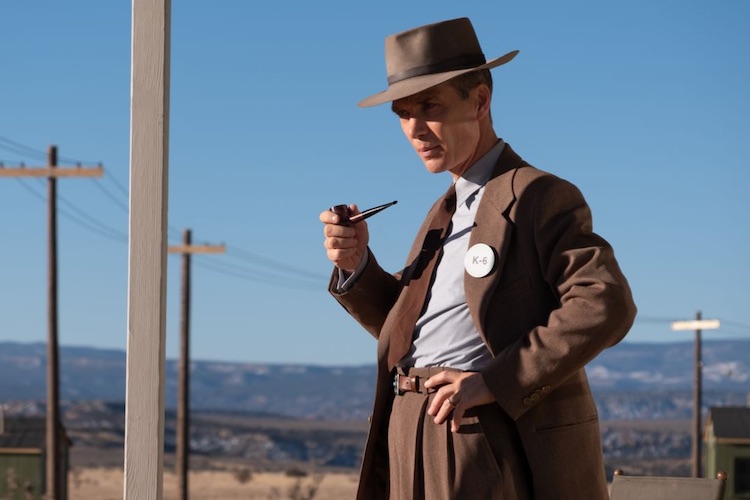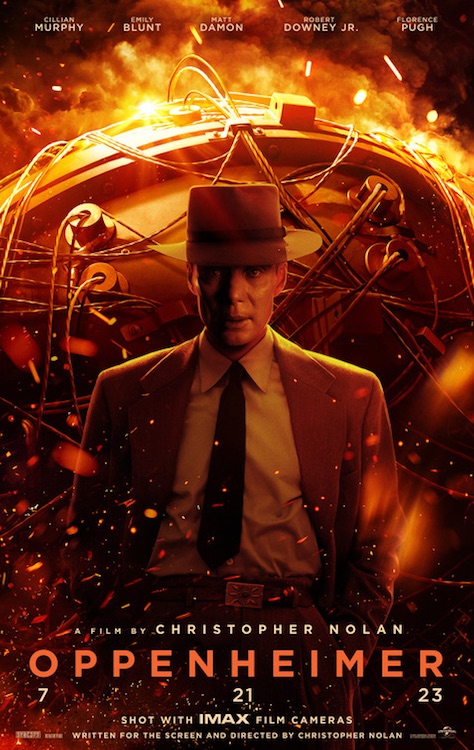
Movie Review: Oppenheimer
What We Liked
What We Didn't Like
In a summer dominated by IP, Christopher Nolan continues to be a brand unto himself. Who else would be able to spend nearly $200 million to make a three-hour, dialogue-heavy drama about the nuclear arms race and ideological divides? Whatever flaws Oppenheimer might have – and we’ll get there – it’s worth celebrating that, in a summer of reboots, sequels, and brand management, it’s a studio release fueled by weighty ideas, designed not to distract audiences but to reflect.
It’s easy to think Oppenheimer might be a departure not only for the summer movie season but also for its famous director. After all, Nolan is best-known as a filmmaker of spectacle and heady genre fare. It’s been a long time since he’s directed a movie without large-scale action or a sci-fi premise.
But Oppenheimer is remarkably on brand. With a tortured protagonist haunted by the woman he couldn’t save, a fractured timeline that twists and turns in on itself, rich cinematography, and a sound design eager to assault audiences, the director’s trademarks and obsessions are all on full display. For better and for worse, Oppenheimer just might be the most Christopher Nolan film he has made.
The writer/director has always been fascinated with characters fueled by tragedy who, in response, try to control their circumstances, often with the use of new, potentially dangerous, technology. From Memento’s Leonard Shelby to the dueling magicians of The Prestige, and from Inception’s dream thieves to Bruce Wayne himself, Nolan’s stories focus on how obsession only compounds tragedy and how our greatest advancements might also lead to our biggest downfalls. It’s no surprise, then, that he would be interested in J. Robert Oppenheimer, the brilliant physicist who unleashed a hellish threat on mankind.
As with many of Nolan’s films, Oppenheimer’s story unfolds over several separate timelines, each flowing in and out of each other, shifting color palettes and aspect ratios to signify changes in time and perspective. Its main thrust follows Oppenheimer (Cillian Murphy) from his days in university through his recruitment into the Manhattan Project and through the testing and deployment of the atomic bomb. A later timeline observes how the friendships and political associations he held in his earlier years were used against him when his interests conflicted with the U.S. government’s. One last timeline follows the Cabinet hearings of Oppenheimer’s former boss, Lewis Strauss (Robert Downey Jr.), who worries his old friend’s notoriety will undermine his own political ascent.
These stories collide and bounce off each other, sometimes mid-scene, underscoring the film’s themes about how one event, no matter how innocuous or innocent, can set off a chain reaction that affects an entire life, just as a series of microscopic chain reactions can destroy whole cities.
It should come as no surprise that Nolan, who’s long been tantalized by concepts that expand physical and logical boundaries, is fascinated by the work of a quantum theorist whose interests mixed science and art, and who was a pioneer in a field focused on the paradoxes that hold the world together. Murphy gives the best performance of his career. He’s focused and loquacious when need be, but also barely containing emotion when it stirs. Much of the story focuses on him holding his opinions inside, and Murphy is fantastic at hinting at what’s going on behind those eyes as Oppenheimer becomes more aware of the compromises he’s made in the name of progress and patriotism.
The development and testing of the bomb is the strongest section of the film. Nolan imagines Oppenheimer’s point of view with surreal images of stars, wave particles, and abstract light. Despite largely consisting of people sitting in rooms and talking, the film moves at an almost exhausting pace as Nolan bounces back and forth through time, capturing the exchange of ideas and energy that occurs between brilliant people. Much of the film’s conflict, particularly in the postwar scenes, concerns Oppenheimer’s early associations with Communists and their sympathizers, which included many of the scientists recruited to work on the bomb. The film explores the tension of a nation that wants its brightest minds at its disposal but is not beyond shutting those minds down when they come into conflict with their ideals.
The scenes leading where Oppenheimer and his colleagues brainstorm the potential of the bomb and discuss the ethical and moral implications of its existence are fascinating. In addition to Murphy, Nolan gets great use out of a supporting cast that includes a very funny Matt Damon as a no-nonsense general, David Krumholtz as Oppenheimer’s friend and conscience, Josh Hartnett as a colleague who tries to help Oppenheimer keep politics out of the classroom, and Kenneth Branagh as a revered scientist and mentor.
All of these men (we’ll get to the women shortly) bring their ideas, concerns, and politics to the table and contribute to the construction of “the gadget,” as they call it. They discuss the potential danger of unleashing a weapon that causes such mass destruction – and has a not-zero chance of igniting the atmosphere – but in the end, there’s consensus that having a bomb that only needs to be used once could potentially stop all bombs from being dropped ever again. But as Oppenheimer himself notes, theory isn’t reality, and what makes sense in the lab or classroom plays out differently in the hands of politicians and military strategists who are eager to leave the scientists out to dry. And, as someone states, it will only keep the peace until someone builds a bigger bomb.
Murphy captures the hesitancy and wariness in Oppenheimer’s eyes, but also remains clear-eyed about his long refusal to take responsibility for the world his project ushered in. He’s cautious to take a public stance on his beliefs or ideologies, and eventually chooses to hide behind the fame to suit his interests. During a victory speech to the Los Alamos workers, the director indulges in surreal imagery to suggest Oppenheimer’s guilt while, on the surface, he boasts that he wishes they could have also dropped the bomb on the Germans. In another sequence, as U.S. officials show footage of the bombs’ physical devastation in Japan, he refuses to look.
Unfortunately, Nolan also juxtaposes this with the guilt Oppenheimer feels for his marital infidelity and the subsequent suicide of his lover, Jean (Florence Pugh). While Nolan’s script creates robust and lively roles for its scientists and politicians, the director continues to prove unable to create sympathetic female characters. Jean is a one-dimensional tragic muse depicted only by her emotional instability and neediness, and while the film features the most nudity and sex of any Nolan film, his inability to capture passion or tenderness makes it just as sexless as any of his previous movies. Emily Blunt fares even worse as Oppenheimer’s wife, Kitty. The film reduces a fascinating real-life character to three traits: she hates her kids, doesn’t care too much for her husband, and loves her booze.

Cillian Murphy in “Oppenheimer.” Photo by Melinda Sue Gordon/Universal Pic/Melinda Sue Gordon – © Universal Pictures. All Rights Reserved.
Given Nolan’s penchant for spectacle, it’s probably fair to anticipate that the Trinity test at Los Alamos is a massive set piece. But the sequence, which occurs about two-thirds of the way into the film, is handled respectfully. Nolan builds exquisite suspense in the buildup to the test, and the explosion itself is impressive and suitably haunting, an intimidating tower of fire created practically instead of with digital effects. But, rightfully, it never feels like a set piece or a cheer-worthy moment. Instead, it’s an image of force and destruction, a dividing moment in history that has its own subdued gravity.
Technically, the film is one of Nolan’s strongest. Hoyt van Hoytema’s cinematography is gorgeous, and shooting on 70mm allows the movie to capture the sprawling landscapes and energetic classrooms and labs, while also remaining focused on its cast. Ludwig Goransson’s score is powerful and haunting, turning bombastic when needed. And Jennifer Lame’s editing is exquisite. The non-linear storytelling allows the film to hurtle back and forth through time based on emotional and thematic hooks where a traditional narrative might have been too front loaded before growing into a stultifying courtroom drama.
Nolan’s always been skilled with actors, and he might have the year’s best ensemble at his disposal. Murphy is fantastic, and Robert Downey Jr. reminds that he can do more than super heroics. Downey plays clipped, bitter, and petty really well, and it’s one of his strongest performances in years. Alden Ehrenreich, Casey Affleck, Jack Quaid, Jason Clarke, and Matthew Modine round out the slick cast and provide a shorthand for their characters in their brief time. Only Rami Malek seems out of place as a character who originally appears innocuous but plays a major role near the end; the problem is that the very distinctive-looking and affect-heavy Malik can’t play innocuous and is, instead, distracting in his every moment.
The film’s final hour is drawn out about 30 minutes too long, bouncing back and forth between two interrogations in two different timelines. While they fit the film’s themes about Oppenheimer’s buried guilt and the government’s proclivity to turn its back once people have outlived their usefulness – particularly when their beliefs don’t align with their politics – the stretch goes on too long, returning to the same points and tossing in what Nolan seems to think are shocking revelations that the audience has already predicted. None of it is bad or unwatchable – the cast is too good for that – it’s just too much for a movie that has already passed its most interesting moments.
Oppenheimer is flawed but fascinating. There are moments of greatness, yet the overall enterprise falls just short. But despite its shortcomings, it’s still one of the year’s most interesting, thoughtful and masterfully crafted work, and a rare summer movie with something on its very complex mind.



